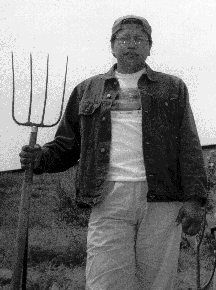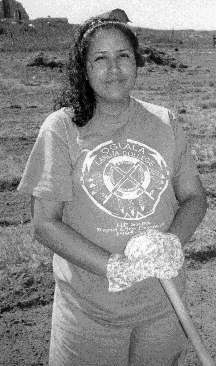Little Finger took the doctor's advice, got an angioplasty, stopped drinking and started exercising. But he went farther than that. He started gardening - organic gardening.
The Sioux have never been known as the great gardening tribe of the Plains. Although the ancestors of today's Lakotas raised some crops, the tribe gained renown for its buffalo hunting. This came to a crashing halt with the Anglo colonization of what was to become the nation's bread basket. The final nail in the coffin of dietary self-sufficiency came with President Nixon's food stamp program in the 1960s.
But four years ago, Little Finger began a still-thriving gardening program at Oglala Lakota College in Kyle, S.D., before planting a garden on his family's land near Pine Ridge.
Why are Little Finger and others on the Pine Ridge Reservation starting to grow their own vegetables? Some say they're doing it for health: By some estimates, half the adults on the reservation have diabetes, which was unheard of before the 1940s. But Robert Quiver, a student activist at the college, says they're doing it to regain their independence.
"Gardening on the reservation is a statement," says Quiver, founder of the Lakota Student Alliance. "It says people can be self-sufficient ... We should be able to provide our own food supply, instead of being dependent on commodities and junk food, which I think is responsible for our diabetes."

Quiver and eight other native students spent last summer cultivating the hillside just below the college. In beds rototilled out of the prairie, they grew squash, corn, beans, tomatoes, chard, broccoli and turnips. They got help from a surprising source: an equal number of students from the University of Bonn in Germany, who came for a summer of gardening and learning about Lakota culture.
The fruits of their joint labor go to the people living in and around Kyle. The know-how of gardening without irrigation hookups, tractors or fancy tools will stick with students who will have to run their own gardens on very little money. In that, they will be like the program that trained them.
"We operate on a shoestring budget, we really do," says instructor Theresa Contos. "Some of the local merchants have donated a few things, but it's nothing consistent. Nothing you can count on. That's why we have all these grass paths (between the vegetable beds), so the prairie can heal itself and won't turn into a huge weed patch if everything comes to a crashing halt."
Indian colleges are used to existing on the financial margin. They've received federal assistance since 1978, but that averages out to $2,900 per student, while community colleges off the reservation typically get about $4,000, and public universities get much more.
"As a result, the tribal colleges need to come up with creative ways to stay in business," says David Cournoyer of the Denver-based American Indian College Fund. "That includes teaching in trailers, in warehouses and converted BIA buildings. It also means the staff at these colleges have to do several different things."
The seven-year-old American Indian College Fund injected about $50,000 of private money into each of the nation's 29 Indian colleges last year. Another step toward closing the gap was taken in 1994, when Congress made the Indian colleges land-grant institutions. That grouped Indian colleges with 74 other universities and colleges all over the country, which have historically been mandated, and subsidized, to teach agriculture and other rural-oriented subjects. Hopes are high that land-grant status will bring the kinds of benefits to Indian lands that schools like Utah State and the University of Arizona bring to their states: They send graduates home with advanced degrees in agriculture and natural resource management, and extension agents out to offer advice on gardening, ranching and other subjects.
This year, federal land-grant funding for all of the Indian colleges will come to a total of about $9 million. (By comparison, non-Indian land-grant institutions will receive over $700 million.) Part of Oglala Lakota's share will go toward extending the organic gardening program to all parts of the reservation.
One of the many tribal college faculty reacting with cautious optimism to this new federal source of money is Leslie Henry, an Anglo who grew up just outside the reservation and now directs the gardening program. She's seen plenty of outsiders try to help the Lakota rather than encouraging them to help themselves.
"We've had people who want to give everyone on the reservation a greenhouse," she says. "And I say, 'Hey, are you going to educate them on how to use them?' The same person just shipped chickens to them without any information on chicken coops or anything. They had them in their living rooms."
The Lakota students' ages average in the late 20s, and many of them have families. Children run between the vegetable beds, and two little boys stumblingly help their father string wire for a new fence. The German students are younger than their Lakota cohorts. Most of them are undergraduates, many of them in horticulture.
This pairing may seem strange, but it seems to work. The program's founder, Leonard Little Finger, brought the groups together after he met Heinrich Welzing, a horticulturist from the University of Bonn, at a workshop in Maryland.
"They're very work-oriented, like our ancestors," said Little Finger. "We exchange our past with them; they exchange their present with us. And the Germans and Lakota are very compatible." Among Anglo Americans, he points out, there's still a lot of racism. "At 4-H camp the other day, a young instructor told a joke about chiefs and squaws."
 Martin Witt, a newly graduated German engineering student, says his group is here for primarily cultural reasons. "There's a new racism in Germany," he says. "What can you do against it? All you can do is set a better example. We're trying to take part in Indian life to the point we're invited. And we're getting invited to the houses and the families. We have a lot of discussions on how we're seen here as Germans. We have nothing to do with what happened to the Indians here. We have our own history. A lot of German youth don't identify with our own country. Foreigners know Boris Becker and Adolph Hitler; I am neither."
Martin Witt, a newly graduated German engineering student, says his group is here for primarily cultural reasons. "There's a new racism in Germany," he says. "What can you do against it? All you can do is set a better example. We're trying to take part in Indian life to the point we're invited. And we're getting invited to the houses and the families. We have a lot of discussions on how we're seen here as Germans. We have nothing to do with what happened to the Indians here. We have our own history. A lot of German youth don't identify with our own country. Foreigners know Boris Becker and Adolph Hitler; I am neither."
Jenny Martin, a Lakota taking the summer course with her mother (students can study organic gardening for up to two years at the college), appreciates the helpfulness and technical expertise of the German students.
"Those girls are so strong," she marvels. "One day I want to have my own organic garden to feed my family. A lot of people don't have the money to travel long distances to buy food. I think this is empowering us to be able to take care of ourselves."
For more information, contact:
Leslie Henry, Oglala Organic Gardening Project, Oglala Lakota College, P.O. Box 490, Kyle, SD 57752, or the American Indian College Fund, 1111 Osage St., Bldg. D, Suite 205-A, Denver, CO 80204 (303/892-8312, 800/776-FUND).
The Tribal College Journal of American Indian Higher Education published a special issue on agriculture in Fall 1995. It is available by sending $5 to the Journal at P.O. Box 720, Mancos, CO 81328.
